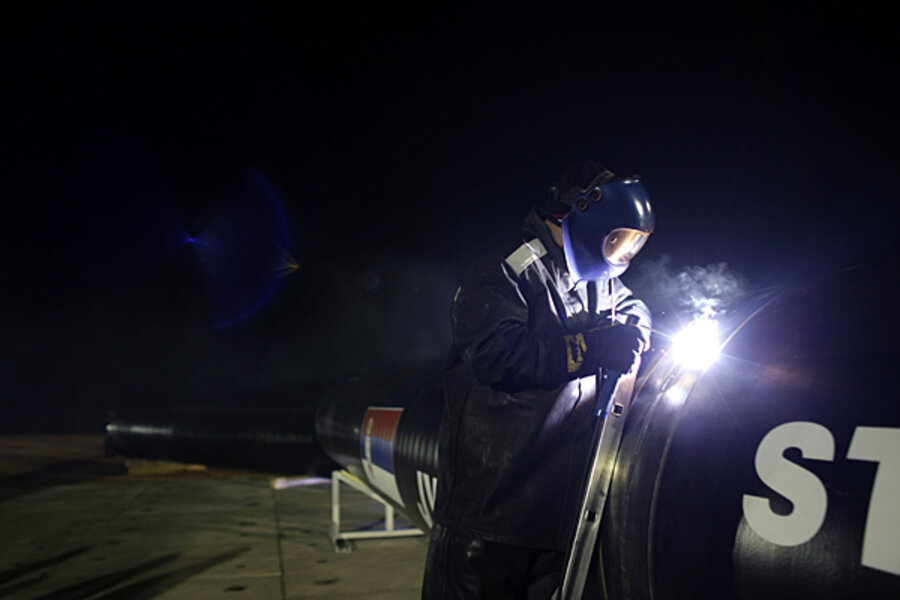Will Ukraine crisis derail Russia's southern gas pipeline?
Loading...
When completed, the South Stream pipeline will run from Russia, underneath the Black Sea to Bulgaria, and on to Western Europe. It will carry Russian natural gas to Europe while bypassing Russia’s neighbor Ukraine. Russia clearly finds this pipeline to be strategically important – the Kremlin would be able to operate with greater freedom when using natural gas to bully Ukraine, and it wouldn’t have to worry about angering its large customer base in Western Europe. However, the project is very much in doubt as the standoff between Russia and Ukraine has escalated once again.
“Activists” in the eastern provinces of Ukraine seized a local government building on April 7 and declared the independent republic of Donetsk. They then called for the Russian military to come to their new republic to ostensibly keep the peace. The whole charade had a heavy stench of inauthenticity, and it presaged a new Russian military incursion into Ukraine, perhaps to seize more territory from the government in Kiev. As of April 8, it appeared that the Ukrainian government had taken back control of the government buildings in its eastern provinces, but it is unclear how Russia will respond. (Related Article: Russian Sanctions and the Negative Effect on Global Energy Security)
The EU held talks in Brussels to discuss the potential disruption of Russian gas moving through Ukraine. While Russia cutting off gas flows would do a lot of damage to Russia itself, that prospect can no longer be considered an unlikelihood. Gazprom has already jacked up prices on Ukraine by 81%, which the government in Kiev has said it will not tolerate. Ukraine’s interim Prime Minister Arseniy Yatsenyuk said on April 5 that Ukraine needs to begin to prepare for natural gas supply disruptions. “Russia was unable to seize Ukraine by means of military aggression. Now they are implementing plans to seize Ukraine through economic aggression,” he said. To make matters worse, Gazprom’s chief justified the $11.4 billion debt owed by Ukraine by arguing that Russia no longer needs to pay Ukraine to use the Sevastopol port for its Navy – because it is now on Russian territory. Never mind the fact that Russia doesn’t feel it needs to reimburse Ukraine for expropriating its territory and assets.
All this is to say that the row over natural gas specifically seems to be growing. Should the conflict escalate further – if, say, Russia decides to send in the thousands of troops it has amassed along the border with Ukraine, or it does in fact cut off gas to Ukraine – Russia’s relationship with Europe would hit a fresh low. That could put the entire $45 billion South Stream pipeline into doubt.
The pipeline is in the early phases of construction as Gazprom is laying down pipe in Russia, Bulgaria, and Serbia, but the EU Energy Commissioner has already frozen talks in retaliation for the annexation of Crimea. Its future is now up in the air. According to the Wall Street Journal, the chief executive of Eni, which holds a 20% stake in South Stream, told an Italian parliamentary committee in March that the fate of South Stream was “somewhat murky.” (Related Article: A U.S.-Saudi Move to Lower Oil Prices?)
Europe is looking for alternative supplies of energy to the pipelines that run through Ukraine. They have lately been lobbying heavily in Washington for swifter approval of LNG export terminals, but it may be several years before LNG begins moving from U.S. ports in substantial volumes. The EU is also hoping to complete the Trans-Adriatic pipeline, which could be seen as a competitor pipeline to South Stream, but it will not come online for another five years. Gazprom executives believe they can bring South Stream online by the end of 2015. By freezing talks on South Stream, the EU is trying to pressure Russia to back down on Ukraine, but it is unclear how far it is willing to go. In the short and medium-term, the EU will still be highly dependent on Russia for energy. Yet, if Russia invades Ukraine’s eastern territories, the EU may make a bolder effort to kill the South Stream project. What happens next is anyone’s guess.







